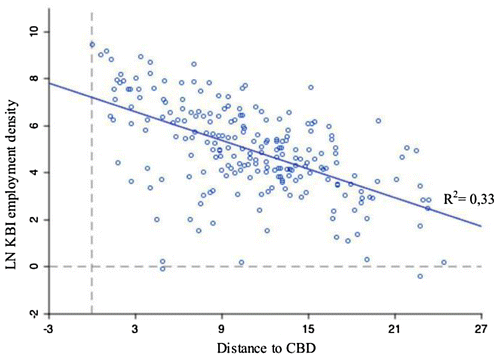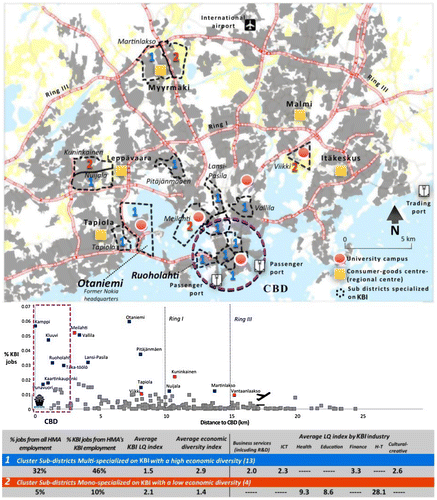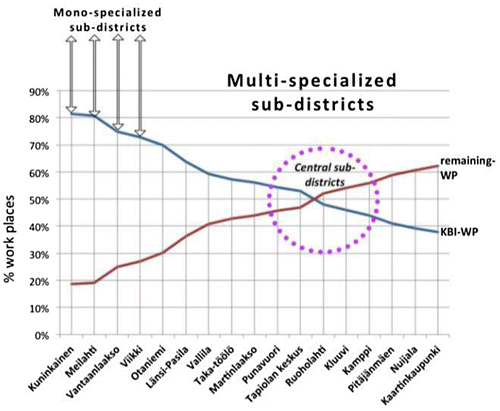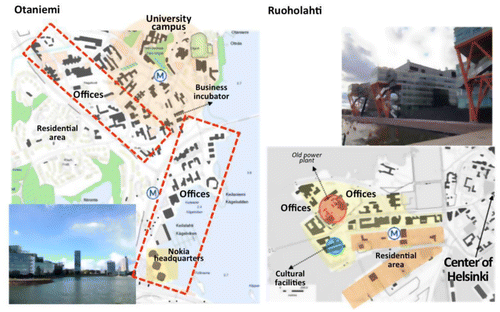ABSTRACT
The central locations of metropolitan areas have some specific attributes, leading to an accumulation of large knowledge exchanges and extensive knowledge externalities, which encourage the concentration of various economic activities, especially knowledge-based industries (KBI). Other agglomeration economies found in metropolitan areas – such as telecommunications and transport infrastructures connected to global productive circuits and complementary labour markets – are key factors for KBI employment growth. This paper explores the Helsinki Metropolitan Area’s (HMA) spatial clustering of KBI at the sub-district level, and the role played by agglomeration economies (both specialization and diversity economies) in fostering this process. The results reveal that KBI employment shows patterns of concentration in the core and adjacent areas. The specialization and diversity economies found in the metropolitan core and the specialization economies found in others areas lead to KBI spatial clustering in the HMA. Public policies regarding the promotion of science parks have also played a decisive role.
INTRODUCTION
The increasing value of skills and other agglomeration economies (both specialization and diversity economies) found in the central locations of metropolitan areas encourage employment growth in knowledge-based industries (KBI). The earlier works of Lucas (Citation1988) and Romer (Citation1987) claim that knowledge and innovation tend to be localized because of their contextual properties. This leads to the creation of knowledge spillovers, benefitting economic activities performed in geographical proximity (Aslesen & Isaksen, Citation2007). In relation to KBI, public policies often boost cluster development, stressing the importance of specialization economies and intra-industry spillovers. However, KBI are heterogeneous, in terms of skills and market requirements (Chica, Citation2016); hence, the persistence of their location patterns in metropolitan areas – particularly in the cores – supports the idea that specialization economies and diversity economies together determine the location of KBI. Accordingly, the research question is how spatial clustering of KBI employment is affected by the interplay between diversity economies, which are mainly found in the metropolitan core as ‘a natural growth’ of economic activity, and specialization economies, which are result of the effects of cluster policies.
This will be investigated at the sub-district level of the Helsinki Metropolitan Area (HMA), through (1) the definition and classification of the largest KBI employment areas; (2) an analysis of the effects of the distance to metropolitan core on KBI employment density; and (3) an examination of the urban features of two key KBI clusters, to understand how diversity and specialization economies interact in the configuration of the cluster.
The role of agglomeration in KBI clustering
Agglomeration economies (or externalities) have been extensively highlighted in the literature as the decisive factors for the location of economic activities. The concept was introduced by Marshall (Citation1890), attempting to explain industrial concentration, which leads to reduced production costs and productivity increases. Hoover (Citation1937) differentiates agglomeration economies from localization economies (a common labour pool, suppliers, knowledge spillovers, etc.), which are external to the firm but internal to the industry; and urbanization economies (size of urban market, infrastructures, etc.), which are external to both the firm and the industry, but internal to an urban geographical area.
Among agglomeration economies, knowledge spillovers have a prominent role in KBI clustering since from the perspective of firms, knowledge production is a private good (Boschma, Citation2005). Hence, knowledge spillovers are often confined to a relatively limited space, frequently near universities (Audretsch, Lehmann, & Warning, Citation2004) or in metropolitan cores where frequent face-to-face contacts occur (Storper & Venables, Citation2004). Therefore, clustering processes are related to access to knowledge spillovers and other agglomeration economies (Aslesen & Isaksen, Citation2007). Glaeser, Kallal, Scheinkman, and Shleifer (Citation1992) introduce the idea that knowledge spillovers can produce irreversible changes in production, and therefore lend a dynamic character to externalities’ effects. Thus, they differentiate between (1) Marshall–Arrow–Romer (MAR) externalities, which concern knowledge spillovers in an industry; (2) Porter’s (Citation1990) externalities, where local competition fosters the pursuit and rapid adoption of innovation;Footnote1 and (3) Jacobs (Citation1968) diversity externalities, where knowledge spillovers occur between firms in complementary industries by a cross-fertilization process. Recently, Frenken, Van Oort, and Verburg’s (Citation2007) concept of relatedness emphasizes the role played by inter-industrial knowledge spillovers in highly related industries in fostering economic growth. Henderson, Kuncoro, and Turner (Citation1995); Feldman and Audretsch (Citation1999); Shearmur and Doloreux (Citation2009) and Bishop (Citation2009) have also studied the interaction of specialization and diversity economies in encouraging KBI clustering; their findings argue that diversity economies have an important role in encouraging KBI employment growth, because of their importance for innovativeness, while specialization economies are important for retaining these activities in clusters.Footnote2
Helsinki Metropolitan Area (HMA)
HMA is the most populous and economically dynamic area in Finland, with 1.07 m inhabitants (20% of Finland’s population) and 615,000 jobs (26% of national employment) (Statistics of Finland).
In the late 20th century, HMA became one of Europe’s leading clusters in ICT. Recently, public policies encouraged large-scale entrepreneurial initiatives, alongside improving competitiveness and internationalizing the economy. Urban policies in the region have also encouraged regional competitiveness and attractiveness (Inkinen, Citation2015). Hence, top-down policies helped create a network of technology parks (Pelkonen, Citation2005). These strategies stem from intense cooperation between local governments, universities, and firms. The dominant mode of action in promoting Finnish regional development is based on policy networks (Sotarauta, Citation2010). In HMA, this cooperation has been undertaken through intermediary agencies such as Tekes (Finnish Funding Agency for Technology and Innovation) and Helsinki Business Hub, while semi-public companies such as Technopolis develop and manage technology parks (Pelkonen, Citation2005).
METHODOLOGY AND DATA
2010 employment data at two digits of NACE Rev2 classificationFootnote3 in 232 sub-districts (with KBI employment) were used (Statistics of Finland). The industries studied are those identified by the Organisation for Economic Co-operation and Development (OECD) (Citation2001) as high-tech manufacturing and knowledge-intensive services (ICT, research and development (R&D), finance, business services, health and education); cultural–creative are also included, using the EUROSTAT classification. The methodology comprises three steps:
| • | Identification and classification of the major KBI employment areas via employment size and employment density criteria,4These large KBI employment areas can be assimilated to employment sub-centres. Garcia-López (2007), following Giuliano and Small (1991), proposes as thresholds for the definition of employment sub-centres an employment share greater than 1% of metropolitan employment and an employment density greater than the average. using principal components factor analysis (PCA) and hierarchical and K-means cluster analysis. PCA reveals relationships between employment variables by identifying new and uncorrelated variables (factors), which contain those relationships patterns. Cluster analysis reveals homogenous groups (clusters) of sub-districts, using PCA factors. Variables included in PCA are KBI employment density, KBI employment share, KBI specialization (location quotient – LQ), and overall diversity economic index, using an orthogonal varimax rotation to maximize results. Four factors resulted: the F1 and F2 factors reflect mixed specializations in ICT and finance; and business services, education and cultural–creative, respectively (Table 1). Economic diversity appears more related to industrial specialization that the F2 represents. The remaining two factors (F3 and F4) reflect mono-specialization in health and high-tech manufacturing. | ||||
| • | A regression analysis of the factors determining KBI employment density (dependent variable), with explanatory variables being distance to the metropolitan core or central business district (CBD), and the economic diversity and the employment specialization coefficients. | ||||
| • | Analysis of urban features of two of HMA’s major KBI clusters (Otaniemi & Ruoholathi). | ||||
Table 1. Principal components factor analysis (PCA) results.
Identification and classification of major KBI employment areas in HMA
HMA has high KBI specialization: HMA accounts for 30% of national KBI jobs compared with 26% of all employment. Considering only business-orientated KBI (ICT, R&D, high-tech manufacturing, finance and business services) (Chica & Marmolejo, Citation2016), HMA accounts for almost half of nationwide KBI employment (47%). In other words, in terms of competitive advantage, it remains more profitable for KBI firms – specially business-orientated KBI – to be located in HMA than elsewhere.
Two major kinds of KBI agglomerations can be distinguished. First, there are 13 KBI multi-specialized (finance, ICT, business services and cultural–creative) sub-districts, which also have high economic diversity figures. They account for 46% of HMA’s KBI employment, and are mainly located in central Helsinki and its outskirts; some are also located around the highway (Ring I) that crosses the metropolitan area, 10 km (on average) from the CBD. Most multi-specialized sub-districts arose from the ‘natural growth’ of KBI employment. However, those far from central Helsinki resulted from cluster policies creating specialized technological parks – mainly in telecommunications and high-tech manufacturing, such as Otaniemi, Ruoholahti and Pitäjänmäaen, which have diversified their productive structure during the last two decades.
The second group consists of 4 KBI mono-specialized (health, education or high-tech manufacturing) sub-districts, with low economic diversity values and accounting for 10% of HMA’s KBI employment.
Figure illustrates both multi-specialized (1) and mono-specialized, (2) sub-districts presenting percentage of KBI employment, and average values for (a) LQ for leading specializations and (b) economic diversity.
Analysing the internal sub-districts’ employment structures confirms the role of KBI employment. In the multi-specialized sub-districts, KBI employment figures range from 40% (Niujala) to 70% (Otaniemi) of overall employment, illustrating their diverse employment structure. By contrast, in the mono-specialized sub-districts, KBI employment accounts for over 70% of overall employment, indicating strong labour market specialization (Figure ).
The interplay of diversity and specialization economies encourages KBI spatial clustering in HMA. Spillovers from economic diversity encourage spatial clustering of multi-specialized KBI: the multi-specialized sub-districts’ diversity index (2.9) is larger than the average for the whole HMA (2.5) and twice that of the mono-specialized sub-districts. On the other hand, specialization economies associated with specialized labour pools, knowledge spillovers and scientific communities encourage mono-specialized clustering in certain KBI: high-tech manufacturing, health and education. While a large number of KBI multi-specialized sub-districts are located in the CBD and its outskirts, most KBI mono-specialized sub-districts are far from the CBD; central Helsinki has the highest value for the economy diversity index (3.40) for the whole metropolitan area. Therefore, one would expect that proximity to the CBD affects KBI employment density, analysed in the next section.
HMA’s KBI employment density determinants
KBI employment density is greatly affected by the distance to the CBD (Figure ), confirmed by the regression analysis (Table ). Distance to CBD is the largest explanatory variable influencing KBI employment density, followed by KBI specialization (LQ) and economy diversity index. However, it should not be forgotten that the CBD, as mentioned above, has the greatest employment diversity in HMA and accumulates substantial KBI specializations.
Figure 3. Variation of the ln of KBI employment regarding the distance to the central business district (CBD).

Table 2. Results of the regression model.
Additionally, Moran’s I test (which examines spatial autocorrelation of the dependent variable), is positive and significant in lower ranges of contiguity (.47); but negative and not significant (–.14) in high ranges of contiguity. As mentioned, in the most central sub-districts, there is KBI multi-specialization, which suggests a spatial dependence in KBI clustering; however, this is not the case elsewhere in HMA, where KBI clustering does not seem to encourage cross sub-district spillovers. Nevertheless, given the relatively small unit of analysis (sub-districts), it cannot be ruled out that cross-spillovers exist at the whole metropolitan area level, where KBI firms can access complementary and competitive knowledges.
Otaniemi and Ruoholahti multi-specialized sub-districts
Otaniemi is a good example of a contemporary milieu where physical proximity and interconnectedness boost collaborative work between public and private actors. The park was consolidated in the 1990s, thanks to the location of the Nokia headquarters. It occupies 4 km2, has a university for technology and the arts and headquarters of large companies, with 18,000 workers and 16,000 students. ICT, nanotechnologies and mobile–wireless technologies are the leading KBI specializations. The Innovation Garden is the new policy strategy for the development of Otaniemi, including a strong entrepreneurial component.
Ruoholahti arose from the urban renewal of a former cargo port bordering central Helsinki in the late twentieth century. It occupies 0.5 km2, including a business area, 3500 flats, a cultural centre and other amenities. ICT, electronics and finance are the leading KBI specializations, employing 14,000 workers.
Otaniemi is a mixture of technology park and high-tech industrial complex. Ruoholahti is a better example of a high-tech industrial complex. Both result from top-down policies, though each has its own level of participation of public actors. In Ruoholahti, the public’s role was essential for the urban renewal that led to the park development; in Otaniemi, local government cooperates with the university and companies in park management and development. Figure illustrates schematically the land uses and morphology distribution in both.
Conclusions
This paper explores the spatial clustering of KBI employment in HMA and the role of agglomeration economies (both diversity and specialization).
First, the analysis shows that the interplay of both diversity and specialization economies encourages the clustering of KBI employment in multi-specialized and mono-specialized sub-districts. Second, geographical proximity to the CBD is a key factor for KBI employment growth, emphasizing the CBD’s major advantages in terms of agglomeration of complementary activities: aspects that Jacobs (Citation1968) links with knowledge creation, and Storper and Venables (Citation2004) with the development of buzz environments, where knowledge spillovers arise through face-to-face contacts between economic agents encouraged by physical proximity. Third, recent urban policies in the design of technology and scientific parks emphasize the importance of both specialization and diversity economies, through their location in central, well-connected areas, and promoting mixed land uses.
Thus, both urban renewal policies in central areas and development policies of strategic and well-connected zones have been used as mechanisms for KBI clustering in HMA. Additionally, the direction of the urban policies in the development of those clusters is also focused on promoting mixed land uses.
Acknowledgments
The author thanks Professor Mari Vaattovaara for her support during the author’s internship. Thanks also to the Helsinki Region Environmental Services (HSY) and Statistics Finland for geographical and statistical information; and Sabrina Lai and the external reviewers for their insightful comments.
Additional information
Funding
Notes
1. Porter’s theory has been criticized because the concept of competitiveness does not recognize different modalities that competition can assume at the level of firms, regions or nations (Turner, Citation2001); and because the spatial aggregation of the cluster lacks definition in terms of both industrial and geographical boundaries (Martin & Sunley, Citation2003).
2. Additionally, recent literature focuses on the effects of network economies, as theorized by Castells (Citation1996) and Capello and Nijkamp (Citation1996), in explaining KBI clustering (Boix & Trullén, Citation2007). The paradigm of network economies is based on the idea that interaction between economic players working across great geographical distances (thanks to information and communication technologies (ICTs) and long-distance transport infrastructures) generates externalities located in the nodes of those networks that are metropolitan areas.
3. In detail, for the NACE Rev2 classification, see http://ec.europa.eu/eurostat/ramon/nomenclatures/index.cfm?TargetUrl=LST_NOM_DTL&StrNom=NACE_REV2.
REFERENCES
- Aslesen, H. , & Isaksen, A. (2007). Knowledge intensive business services and urban industrial development. The Service Industries Journal , 27 , 321–338. 10.1080/02642060701207239
- Audretsch, D. , Lehmann, E. , & Warning, S. (2004). University spillovers: Does the kind of science matter? Industry and Innovation , 11 , 193–206. 10.1080/1366271042000265375
- Bishop, P. (2009). Spatial spillovers and employment growth in the service sector. The Service Industries Journal , 29 , 791–803. 10.1080/02642060902749310
- Boix, R. , & Trullén, J. (2007). Knowledge, networks of cities and growth in regional urban systems. Papers in Regional Science , 86 , 551–574. 10.1111/pirs.2007.86.issue-4
- Boschma, R. (2005). Proximity and innovation: A critical assessment. Regional Studies , 39 , 61–74. 10.1080/0034340052000320887
- Capello, R. , & Nijkamp, P. (1996). Telecommunications technologies and regional development: Theoretical considerations and empirical evidence. The Annals of Regional Science , 30 , 7–30. 10.1007/BF01580535
- Castells, M. (1996). The rise of the network society . Oxford: Blackwell Publishers.
- Chica, J. E. (2016). Knowledge economy’s externalities and urban growth. An analysis for Barcelona and Helsinki metropolitan areas . Unpublished Doctoral dissertation. Polytechnic University of Catalonia, Barcelona, Spain.
- Chica, J. E. , & Marmolejo, C. (2016). Knowledge economy and metropolitan growth: Barcelona and Helsinki metropolitan areas as case studies. International Journal of Knowledge-Based Development , 7 , 22–42. 10.1504/IJKBD.2016.075436
- Feldman, M. P. , & Audretsch, D. B. (1999). Innovation in cities: Science-based diversity, specialization and localized competition. European Economic Review , 43 , 409–429. 10.1016/S0014-2921(98)00047-6
- Frenken, K. , Van Oort, F. , & Verburg, T. (2007). Related variety, unrelated variety and regional economic growth. Regional Studies , 41 , 685–697. 10.1080/00343400601120296
- Garcia-López, M. (2007). Estructura Espacial del Empleo y Economías de Aglomeración: El Caso de la la Región Metropolitana de Barcelona. [The spatial structure of employment and agglomeration economies. The case of Barcelona Metropolitan Region] ACE , 2 , 519–553.
- Giuliano, G. , & Small, K. (1991). Subcenters in the Los Angeles region. Regional Science and Urban Economics , 21 , 163–182. 10.1016/0166-0462(91)90032-I
- Glaeser, E. , Kallal, H. D. , Scheinkman, J. A. , & Shleifer, A. (1992). Growth in cities. Journal of Political Economy , 100 , 1126–1152. 10.1086/261856
- Henderson, J. V. Kuncoro, A. , & Turner, M. (1995). Industrial development in cities. Journal of Political Economy , 103 , 1067–1090. 10.1086/262013
- Hoover, E. M. (1937). Location theory and the shoe leather industries . Cambrige, MA: Harvard University Press. 10.4159/harvard.9780674498624
- Inkinen, T. (2015). Reflections on the innovative city: Examining three innovative locations in a knowledge bases framework. Journal of Open Innovation: Technology, Market, and Complexity , 1 (1), 1–23.
- Jacobs, J. (1968). The economy of cities . London: Weidenfeld.
- Lucas, R. (1988). On the mechanics of economic development. Journal of Monetary Economics , 22 , 3–42. 10.1016/0304-3932(88)90168-7
- Marshall, A. (1890). Principles of economics . Basingstoke: Macmillan.
- Martin, R. , & Sunley, P. (2003). Deconstructing clusters: Chaotic concept or policy panacea? Journal of Economic Geography , 3 , 5–35. 10.1093/jeg/3.1.5
- OECD . (2001). OECD science, technology and industry scoreboard 2001: Towards a knowledge-based economy . Paris: OECD Publishing.
- Pelkonen, A. (2005). State restructuring, urban competitiveness policies and technopole building in Finland: A critical view on the glocal state thesis. European Planning Studies , 13 , 685–705. 10.1080/09654310500139319
- Porter, M. (1990). The competitive advantage of nations . New York: Free Press. 10.1007/978-1-349-11336-1
- Romer, P. (1987). Growth based on increasing specialisation. American Economic Review , 77 , 56–72.
- Shearmur, R. , & Doloreux, D. (2009). Place, space and distance: Towards a geography of knowledge‐intensive business services innovation. Industry and Innovation , 16 , 79–102. 10.1080/13662710902728001
- Sotarauta, M. (2010). Regional development and regional networks: The role of regional development officers in Finland. European Urban and Regional Studies , 17 , 387–400. 10.1177/0969776409352581
- Storper, M. , & Venables, A. (2004). Buzz: face-to-face contact and the urban economy. Journal of Economic Geography , 4 , 351–370. 10.1093/jnlecg/lbh027
- Turner, A. (2001). The competitiveness of nations: Myths and delusions. In A. Turner & R. Dahrendorf (eds), Just capital the liberal economy (pp. 23–50). London: Macmillan.



